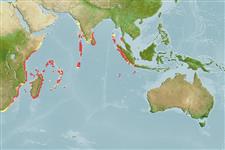Classification / Names
Common names from other countries
Main reference
Size / Weight / Age
Max length : 16.9 cm SL male/unsexed; (Ref. 75973)
Environment
Marine; reef-associated; depth range 6 - 50 m (Ref. 90102), usually 6 - 25 m (Ref. 27115)
Climate / Range
Tropical; 24°C - 28°C (Ref. 27115), preferred ?; 26°N - 34°S, 19°E - 106°E
Distribution
Indian Ocean: East Africa (questionable in the Gulf of Aden and Somalia), east to the Nicobar Islands and Cocos-Keeling Islands (Ref. 75973). Replaced by Bodianus dictynna in the tropical Western Pacific and the the longer snouted Bodianus prognathus in the Line Islands (Ref. 37816).
Countries | FAO areas | Ecosystems | Occurrences | Introductions
Short description
Dorsal
spines
(total): 12;
Dorsal
soft rays
(total): 10;
Anal
spines: 3;
Anal
soft rays: 12. This species is distinguished by the following characters: D XII,10; A III,12; caudal-fin rays 10 - 11 (4) + 12 + 10; pectoral-fin rays ii, 11-15 (3); predorsal scales ?22-25; total gill rakers 15 or 17; head and snout elongate; jaws attenuate; the cheek scales reaching forward on upper side of mouth to below or slightly in advance of anterior extent of orbit, scales reaching forward on lower jaw slightly in advance of posterior corner of mouth; one scale usually apparent midway between corner of mouth and anterior tip of jaw; the upper jaw with first prominent anterior canine equal to or slightly smaller than second; first canine directed anteroventrally, the tip often curved ventrally; second canine directed ventrolaterally and slightly anteriorly, tip occasionally curved ventrally; dental ridge mostly straight with ?6-21 very small canines; one moderately large prominent canine at posterior end of jaw directed anteroventrally and slightly laterally in small individuals, directed more anteriorly in larger specimens; the lower jaw with first prominent anterior canine ?2/3-3/4 length of second; the first canine is directed anterodorsally and usually slightly laterally, tip often curved dorsally; dental ridge usually long and continuous with about 15-22 very small canines in a single row; the teeth becoming only slightly larger posteriorly; teeth occasionally separable into 2 series; the pelvic fin is short, its posterior tip approaching anus only in small individuals (Ref. 75973).
IUCN Red List Status (Ref. 115185)
Threat to humans
Harmless
Human uses
Fisheries: minor commercial; aquarium: commercial
More information
ReferencesAquacultureAquaculture profileStrainsGeneticsAllele frequenciesHeritabilityDiseasesProcessingMass conversion
Tools
Special reports
Download XML
Internet sources
Estimates of some properties based on models
Phylogenetic diversity index
PD50 = 0.5000 many relatives (e.g. carps) 0.5 - 2.0 few relatives (e.g. lungfishes)
Trophic Level
3.4 ±0.5 se; Based on size and trophs of closest relatives
Resilience
Medium, minimum population doubling time 1.4 - 4.4 years (Preliminary K or Fecundity.)
Vulnerability
Low to moderate vulnerability (31 of 100)
Price category
